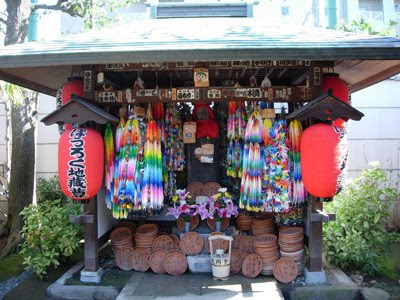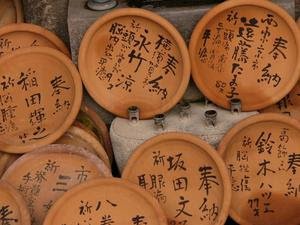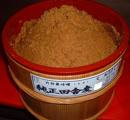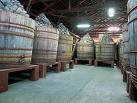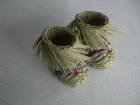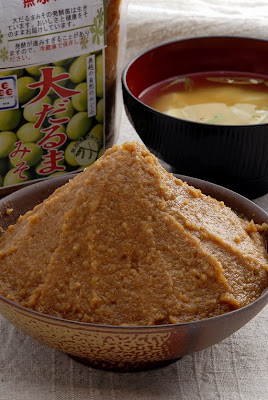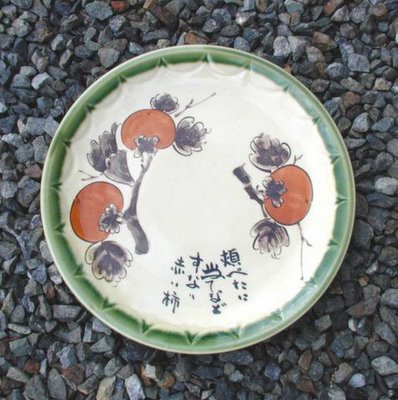::::::::::::::::::::::::::::::::::::::::::::::::::::::::::::::::::::::::::::::::::::::::::::::::::::
Fukui 福井県 / Echizen 越前
under construction
*****************************
Explanation
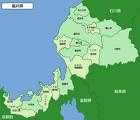
Fukui originally consisted of the old provinces of Wakasa and Echizen, before the prefecture was formed in 1871.
During the Edo period, the daimyō of the region was surnamed Matsudaira, and was a descendant of Tokugawa Ieyasu.
© More in the WIKIPEDIA !
One of the few grand harp makers in the world is in Fukui.
Aoyama Haapu 青山ハープ, Fukui harp 福井ハープ
Tsuruga 敦賀, a traditional harbour where the ships from Hokkaido (Kitamaebune 北前船) used to stop over and unload things, mostly marine products, that were transported to Kyoto by land via the Shiotsu Kaido 塩津街道 along the lake Biwako, linking to Kohoku Shiotsu in Omi. (Kohoku is Northern Shiga region.)
Tsuruga was also the endpoint of the road Tango Kaidoo 丹後街道 Tango Kaido.
:::::::::::::::::::::::::::::::::::::::::::::::::::::::::::::::::::::::::::::::::::::::::::::::::::
Lately, the monstrous jellyfish 越前クラゲ
Echizen Kurage 越前くらげ is a plague for the local fishermen because of their sheer numbers and huge size, they destroy the nets and prevent other fish from being caught.
. . . CLICK here for Photos !
But to turn it into riches, it is now eaten with a special miso mixed with umeboshi sour plum paste.

越前くらげ美食倶楽部 with PHOTO !
Their number has greatly fallen this year !
WASHOKU : November News
:::::::::::::::::::::::::::::::::::::::::::::::::::::::::::::::::::::::::::::::::::::::::::::::::::
Gomadoofu, ごま豆腐
Sesame tofu from the Temple Eiheiji
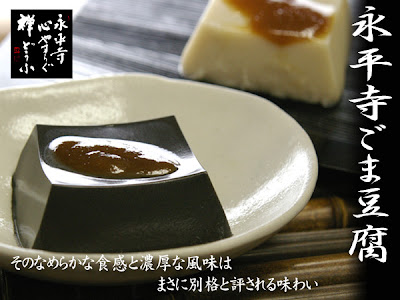
Daruma Museum:
Eihei-Ji Temple 永平寺
Eiheiji ... the cold Zen Temple
:::::::::::::::::::::::::::::::::::::::::::::::::::::::::::::::::::::::::::::::::::::::::::::::::::::
Other specialities from Fukui prefecture
Ayu 鮎 あゆ sweetfish
Adult fish are about 20 cm. Best fished at the rivers Kuzuryu, Asuwa and Hino.
Ayu is a kind of sweet fish, and the size of an adult fish is about 15-25cm. Recently the number of wild Ayu is very small and therefore a large number of baby fish is released into the river every year. The embargo for Ayu fishing is removed in mid June.
Echizen Kani Crabs
Echizengani no nabe 越前がにの鍋 / 越前蟹
Hodgepodge with Echizen crabs,
. . . CLICK here for Photos !
Echizengani sashimi ... with a rather sweet taste of the meat.
The name Echizengani has been "invented" by a local fisherman after the war, to sell his catch in Tokyo.
Echizen Soba, oroshisoba 越前そば(おろしそば)
Buckwheat noodles with grated radish
From 福井県嶺北地方
This is one of the representative health foods of Fukui. They are dark buckwheat noodles served with grated radish and leek and katsuobushi in dashi broth. To add grated daikon with its sharpness directly to the soup is special and had started about the year 1600. The buckwheat is grated in stone basins. There are many soba shops in the prefecture and housewifes have their own recipes.
The name was maybe given by Emperor SHowa, when he visited the area and talked about this "Echizen Soba".
Best eaten in October and November with freshly harvested buckwheat.
. . . CLICK here for Photos !
fugu ふぐ blowfish from Wakasa
They are rased in aquafarming. Best in winter, November to February.
gasaebi, gasa-ebi がさえび Echizen Gasa Shrimp
shrimp from Echizen, especially at the Tojnbo rocks (toojinboo) 東尋坊(とうじんぼう Toshinbo Cliffs.
The Tojinbo Cliffs stretch for about 1 km near Mikuni village in the Ando region.
Tōjinbō is also a well-known place in Japan to commit suicide.
Close to the shako shrimps (garage).
A kind of amaebi (ama-ebi), also called gamaebi (gama-ebi) がまえび. There are more than 8 different kinds of these small shrimp, which can only be eaten fresh at the coast, since they do not keep well.
CLICK here for PHOTOS !
guji ぐじ tilefish
Wakasa guji,specialty of the Wakasa peninsula and one of the finest ingredients in Japanese cooking. Salted Wakasa Guji used to be sent to Kyoto via the Mackerel-Road (saba kaido) along with salted mackerels and Wakasa flatfish, as they are important ingredients for Kyoto cuisine.
Wakasa Guji live in the rough Wakasa peninsula, which is the converging point of warm and cold currents, and are fed by high-quality foods. Therefore they grow large and their meat is fatty. The taste is light but sophisticated.
Habutae mochi 羽二重餅(はぶたえもち) Habutae rice cakes
Habutae was a specialy soft silk fabric produced in the area. These cakes are especially silken.
. . . CLICK here for Photos !
hotaruika ほたるいか Firefly Squid
The main season to enjoy the Hotaruika is between March and June in their breeding period. Fishermen with dragnets catch them when these squid gather in the centre of the Wakasa bay. Eaten squid is to dress with a vinegar and miso (soy bean paste) mixture after dipping them in the boiling water.
imo abekawa 芋あべかわ / abekawamochi 安倍川餅(あべかわもち)
satoimo potato mochi
sweetened and eaten with kinako soybean flower and syrup.
Abekawa is a place in Shizuoka prefecture.
Triangular shape.
. . . CLICK here for Photos !
kaki かき 牡蠣 oysters
Once they become stuck to a reef, oysters remain there by nature, making them very suitable for farming. In Fukui Prefecture, the calm waves of the bay of Wakasa /Obama are ideal for raising oysters. Oysters grown in the bitter cold weather conditions of the Sea of Japan have a great fragrance.
kinoko きのこ white mushrooms
Mushrooms are one of the local products in the Wakasa region. The whole root attached mushrooms are popular for a wide range of cooking, from homemade meals to exclusive cuisine. and a new kind of pearl white mushroom sets itself apart from normal mushrooms.
maitake
the rare ‘Kuro Maitake Mushroom’ (black Maitake mushroom), which grows wild in the natural forest deep in the mountains. Shoryu Maitake Mushrooms are grown in a favourable natural environment. They taste delicious.
kodai sasazuke こだいささづけ perserved sea bream
Kodai Sasazuke is a preserved renko sea bream, salted and pickled with rice vinegar in a wooden barrel. It is a specialty product of the Obama area.
. . . CLICK here for Photos !
kome 米 rice from Fukui
koshihikari, from September on as new rice, since 1956. Originated in Fukui. Another brand is "hana Echizen", flower of Echizen, since 1991. This is the earliest rice of Hokuriku, August to October.
mizuyookan 水ようかん sweetened jellied bean paste
. . . CLICK here for Photos !
Usually this is a delicacy for the hot summer months, abut in Fukui it is eaten in winter, the slices are thinner. and the mikan, standard fair in winter at the kotatsu, is NOT eaten here.
also called "dechi yookan, detchi yookan 丁稚ようかん (でっちようかん)" "jelly for servants"
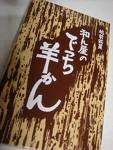
Gelee-Paste aus Azuki-Bohnen.
oobira おおびら
a kind of noppejiru (のっぺい汁)
Served for celebrations. Usually prepared in a huge pot. With chicken meat, chikuwa, radish, carrots, burdock, shiitake, konnnyaku and aburaage tofu. All ingredients are chopped in suitable size and thrown into the boiling water. Soysauce for extra flavor.
. . . CLICK here for Photos !
. oboro konbu おぼろ昆布 shredded konbu kelp seaweed
from Tsuruga 敦賀
:::::::::::::::::::::::::::::::::::::::::::::::::::::::::::::::::::::::::::::::::::::::::::::::::::::
. saba kaido 鯖街道 makerel highway .
- Wakasa Kaido 若狭街道
SABA 鯖 さば MAKEREL
Fukui is famous for the
makerel road (saba kaidoo 鯖街道、さばかいどう- saba kaido) transporting fish to Kyoto. Therefore many simple makerel dishes have been prepared in busy fishing times.
The road leads from the port of Obama at the Bay of Wakasa to Kyoto, about 75 kilometers. The fish was salted and packed in Obama and then carried over night to the city. It was then just righly marinated and folks waited in line to buy it.
Other routes for transporting saba are also known. Many farmers exchanged their newly harvested rice to get some fish for the autumnal autumn festival and their Saba Sushi.
. . . CLICK here for Photos !
Obama was also the endpoint of many ships from Asia trying to reach Japan during its long history. So embassies and their presents for the emperor and aristocrats in Kyoto also travelled along this road, the final step of any "Silk Road" through Asia or via the ocean.
- quote
The most actively used saba kaido road is called "Wakasa kaido", this road is the course to Demachiyanagi in Kyoto, gets out from Ohara, and passes Kutsuki in Takashima City, via Kumagawa-juku in Wakasa town, by Obama City at the starting point.
Detailed information :
- source : sabakaidou.jp/english
- - - - -
saba no hamayaki さばの浜焼き saba makerel grilled on the beach
served with soy sauce and grated ginger, shoogajooyu
. . . CLICK here for Photos !
saba no heshiko さばのへしこ
heshiko, heshikomu is a local dialect of Wakasa for fish fermented in nukazuke 糠漬け rice bran. for saba, iwashi and other blue fish. Later eaten as sashimi or grilled.
This is prepared in the Wakasa area in the extreme cold month of February till early spring only and ready to eat during the hottest season of doyoo in summer. Some families let it ferment for more than one year.
yakisaba nikomi 焼きサバの煮込み
grilled makerel is torn to small pieces and boiled in sweetened soy sauce.
. . . CLICK here for Photos !
saba kan, sabakanzume 鯖缶詰 makerel in tins
is put on rice, sabakan don サバ缶丼
wasabi and soy sauce and sake on top of it わさび酢醤油で鯖缶
. saba 鯖と伝説 Legends about mackerel, Makrele .
:::::::::::::::::::::::::::::::::::::::::::::::::::::::::::::::::::::::::::::::::::::::::::::::::::::
shooryuu maitake しょうりゅうまいたけ / 昇竜まいたけ
"mushroom like a dragon ascending"
black maitake 舞茸
grows in areas of more than 1000 meters hight during the whole year. When people found it, they were so happy they started to dance, hence hte name "dancing mushroom". Since 1988 people started to grow it in farms. It needs a lot of water.
. . . CLICK here for Photos !
Maitake, Klapperschwamm, Laubporling. Grifola frondosa
takuannoni, takuan no nimono たくあんの煮物 boiled takuan
nitakuan 煮たくあん, takuan no nita no たくあんの煮たの
Pickled radish, when it is old, is boiled with soy sauce before eating.
CLICK here for PHOTOS !
ume 梅 plums from Fukui
with small stones, good to make umeboshi or plum wine (umeshu). From June to July they are harvested.
. . . CLICK here for Photos !
unoka うの華 / 卯の華 okara soybean fibers
slightly fried in sesame oil
. . . CLICK here for Photos !
usoba うそば noodles half udon and half soba
prepared in a special maschine.
CLICK here for PHOTOS !
WAKASA bay and the town of Obama
Wakasa guji 若狭ぐじ Japanese Tilefish
kind of red seabream (aka amadai) 甘鯛 amadai
Salted guji has been carried to Kyoto via the Mackerel Road (saba kaidoo) together with mackerels. In the Bay of Wakasa, cold and warm currents meet and is is a rough terrain for fish, so they are fatty.
. . . CLICK here for Photos !
Wakasa Kaki カキ 牡蠣 oysters
They like the cold temperatures in the bay and hang on to the cliffs.
Obama Kodai Sasazuke 小浜 小鯛ささずけ
Renko sea bream is preserved and pickled in vinegar in wooden barrels.

OBAMAまんじゅう / オバマ饅頭
. Obama Manju - for President Obama .
and
Obama Burger made from fish meat
*****************************
Worldwide use
*****************************
Things found on the way
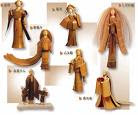
Echizen Takeningyoo 越前竹人形
Bamboo Dolls from Echizen
. Daruma Dolls from Wakasa laquer and agate stone
*****************************
HAIKU
Echizen kurage ...
a monster tamed with
miso paste
Gabi Greve, November 10, 2008
:::::::::::::::::::::::::::::::::::::::::::::::::::::::::::::::::::::::::::::::::::::::::::::::::::::
浮遊する越前くらげニートかな
fuyuu suru Echizen kurage niito kana
floating around
like an Echizen jellyfish ...
poor NEET
Temari Sakura 手毬桜
NEET : Not in Employment, Education or Training
Many young people of Japan are called NEET these days.
::::::::::::::::::::::::::::::::::::::::::::::::::::::::::::::::::::::::::::::::::::::::::::::::::::

野菊むら東尋坊に咲き乱れ
nogiku mura Toojinboo ni sakimidare
wild chrysanthemums
blossom in abundance -
Tojinbo cliffs
. Takahama Kyoshi 高浜 虚子 .
Legends about Tojinbo
One legend has it that a corrupt Buddhist priest from Heisen-ji (平泉寺), a local temple, so enraged the populace that they dragged him from the temple to the sea and, at Tōjinbō, threw the priest into the sea. His ghost is still said to haunt the area.
An alternate legend says that the name Tōjinbō comes from a dissolute Buddhist monk. According to the legend, a Buddhist monk named Tōjinbō, who was disliked by everyone, fell in love with a beautiful princess named Aya. Tōjinbō was tricked by another admirer of Princess Aya and was pushed off these cliffs. The legend says that ever after that time Tōjinbō's vengeful ghost would go on a rampage around the same time every year at this place, causing strong winds and rain. Some decades later, an itinerant priest took pity on Tōjinbō and held a memorial service for him. After that, the storms ceased.
© More in the WIKIPEDIA !
*****************************
Related words
***** WASHOKU : Regional Japanese Dishes
***** .Folk Toys from Fukui .
. Utamakura, place names used in Japanese Poetry .
:::::::::::::::::::::::::::::::::::::::::::::::::::::::::::::::::::::::::::::::::::::::::::::::::::



